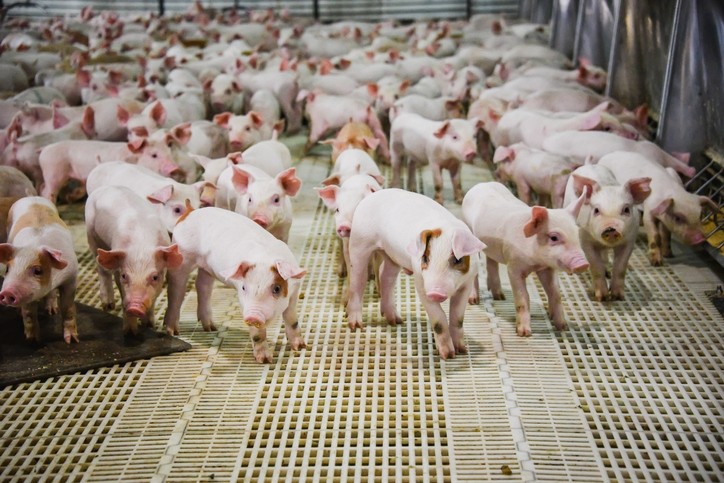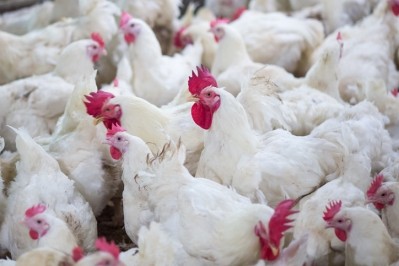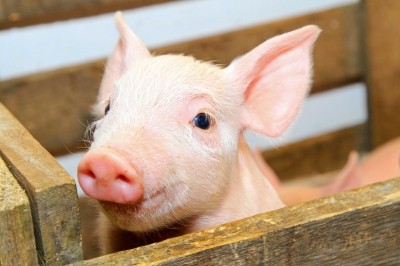Enzyme use may boost piglet gut health, coproduct digestion

A team of researchers from the University of Hawaii at Manoa and North Carolina State University examined the influence of xylanase and mannanase on nutrient digestion and gut health when added to swine diets as a way to improve the use of dried distiller grains (DDGS).
The research group published their work in the journal of Animal Feed Science and Technology.
“The objectives of the study were to 1) determine fermentation characteristics of DDGS and the effect of enzymes in the production of SCFA and BCFA using an in vitro model of swine,” the researchers said. “And 2) determine the supplemental effects of xylanase, mannanase, and their combination on viscosity of jejunal digesta, AID [apparent ileal digestibility] of nutrients, and gut health parameters (villus height and crypt depth, rate of proliferation of crypt cells as indicated by Ki-67, lipid peroxidation or malondialdehyde) in nursery pigs fed corn-soybean meal (SBM) based diets with corn DDGS.”
In the feeding trial, researchers found that adding xylanase to the diet supported the production of propionate, which provided energy to the piglet. And supplemental mannanase expanded production of butyrate and supported gut health.
“These enzymes can be used separately or in combination depending upon the type of ingredients used in the feed and amount of substrate (xylan or mannan) available,” they said. “In this study, corn DDGS was an alternative feedstuff used to evaluate the role of enzymes. However, these enzymes can be used to degrade various other fibrous coproducts.”
Why xylanase and mannanase?
In commercial farming endeavors, common practice is to generate a diet using least-cost ingredients to have a better return on investment, the researchers said. However, the demand and supply of feed ingredient can be “stretched” by competition among feed, food and fuel as well as the decrease in cultivable land.
It is critical to study and improve the use of alternative feed ingredients in different feeding systems and to find methods to use coproducts efficiently in swine diets, they said.
Adding enzymes to degrade non-starch polysaccharide (NSP) could be one method.
“The cell wall of most of the cereals is composed of 60–70% of arabinoxylans (AX), situated mostly in the aleurone and endosperms and lignin situated mostly in pericarp/testa (Bach Knudsen et al., 2017),” they said. “Distillers dried grains with solubles (DDGS), a co-product from bioethanol industry contains 22 to 30% NSP (Pedersen et al., 2014), which is 3–3.5 times more NSP than that is present in the parent grain.”
“The heterogeneous fiber matrix formed by NSP causes encapsulation of starch and other nutrients (Jha et al., 2015),” the researchers said. “This inhibits accessibility of enzymes to nutrients; subsequently, the digestibility of nutrients is decreased.”
A larger amount of NSP in the gastrointestinal tract (GIT) can stimulate fermentation activities and alter gut microbial ecology, they said. Increasing the use of DDGS in diets also can cause oxidative stress, which affects the generation of pro- and anti-inflammatory cytokines.
Supplementing diets with exogenous enzymes may help an animal tolerate such a diet by depolymerizing NSP and improving the digestibility and fermentability of nutrients, they said. These changes also may support a healthier gut and better performance in animals.
“It was hypothesized that supplemental xylanase and mannanase would depolymerize AX and mannan, reduce viscosity of jejunal digesta, increase apparent ileal digestibility (AID) of nutrients, and improve gut health (as indicated by improved intestinal morphology, reduced or no inflammation, reduced oxidative stress, and increased short chain fatty acid (SCFA) production in colon of pigs,” they said.
Methods and materials
Nutrient digestibility was examined in two sets of studies, the researchers said.
In an in vitro trial, the residue of DDGS that had been enzymatically digested were exposed to two levels of supplemental xylanase – 0 or 1,500 endo-pentoseanase unit (EPU) of xylanase/kg of diet – and one of two amounts of supplemental mannanase – 0 or 400 unit of mannanase/kg of diet, they said.
Gas produced by fermentation of the residue and the CO2 released was measured at 0, 2, 5, 8,, 12, 18, 24, 36, 48 and 72h, they said. At the end of the fermentation, period samples were analyzed for short chain fatty acids (SCFA).
The second trial was in vivo, and 32 weaned piglets were given one of four, corn-soybean-based diets with 15% DDGS for a period of 20 days, with six days of adaption on the basal diet, the researchers said. Starting on day 7 the diets also included either 0 or 1,500 EPU of xylanase/kg of diet and 0 or 400 unit of mannanase/kg of diet.
Blood samples were taken on day 18 and all piglets were harvested on day 20, they said. At that point the GIT was collected, digesta samples from the ileum, jejunum and colon were taken and mucosa samples were gathered from the duodenum and middle jejunum.
Samples were checked for tumor necrosis factor-a (TNF-a) and malondialdehyde (MDA) and were used to determine viscosity, pH and apparent ileal digestibility (AID) coefficient of dry matter, GE, NSP, AX and mannan, they said.
Results
In the in vitro trial, the influence of the supplemental enzymes on gas production was first seen at 5h of incubation, the researchers said.
“Supplemental xylanase increased the gas production at 8, 12, 18, 24, 36, 48, and 72 h,” they said. “Supplemental xylanase increased the production of acetate, propionate as well as total SCFA.”
Mannanase was only found to alter the production of butyrate, they said. There was no influence on branched-chain fatty acids (BCFA).
In the in vivo trial, adding xylanase to the feed raised levels of SCFA, propionate, acetate and the AID of total NSP, GE and AX, the researchers said.
“There was also an interaction between xylanase and mannanase on the digestibility coefficient of AX,” they said. “Supplemental mannanase increased AID coefficient of mannan. The AID coefficient of gross energy (GE) was increased with supplemental xylanase.”
No effect was noted on digestibility of protein or cellulose, they said. However, the supplemental xylanase improved villus height in the duodenum, the concentration of claudin, occludin, and zonula occludens (ZO-1) in the jejunum and the proliferation rate in the crypt of the jejunum
Supplemental mannanase boosted production of butyrate, occluding and the AID of mannan, they said. However, it tended to reduce the MDA level in the jejunum.
Additionally, an interaction between the two additives was noted the concentration of ZO-1, the researchers said.
“The use of supplemental xylanase and mannanase were able to improve digestibility of targeted NSP and improve gut health,” they said. “Hence, these enzymes can be used separately or together depending upon the type of ingredients used in the feed and amount of substrate (xylan or mannan) available for enzymes to degrade in diets for nursery pigs to enhance utilization of different fibrous coproducts and improve gut health.”
FeedNavigator is hosting a webinar - Establishing the Microbiota in the Pig - on Tuesday 27 November 2018. Join us as we talk to the experts about how to start the piglet off well.
Source: Animal Feed Science and Technology
Title: Supplemental effect of xylanase and mannanase on nutrient digestibility and gut health of nursery pigs studied using both in vivo and in vitro models
Authors: U. Tiwari, H. Chen, S.W. Kim, R. Jha
DOI: doi.org/10.1016/j.anifeedsci.2018.07.002















